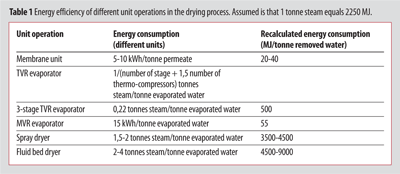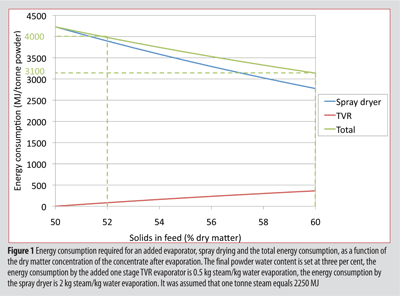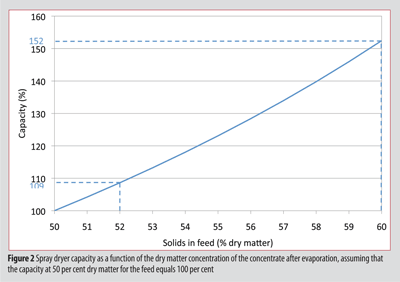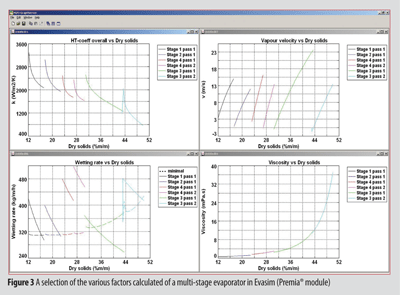Energy reduction by high dry matter concentration and drying
- Like
- Digg
- Del
- Tumblr
- VKontakte
- Buffer
- Love This
- Odnoklassniki
- Meneame
- Blogger
- Amazon
- Yahoo Mail
- Gmail
- AOL
- Newsvine
- HackerNews
- Evernote
- MySpace
- Mail.ru
- Viadeo
- Line
- Comments
- Yummly
- SMS
- Viber
- Telegram
- Subscribe
- Skype
- Facebook Messenger
- Kakao
- LiveJournal
- Yammer
- Edgar
- Fintel
- Mix
- Instapaper
- Copy Link
Posted: 12 May 2010 | Martijn Fox, Coen Akkerman, Han Straatsma and Peter de Jong, NIZO food research | 2 comments
Most of the powder products available on the market are produced using a spray drying process. Drying processes are known to be the most energy consuming processes used in the food industry. For example, the Dutch dairy industry required 1.4 PJ for drying its whey and milk powder in 2007. Therefore, a reduction of the energy consumption in drying processes will result in large cost savings, a better carbon footprint and a more sustainable production chain.
Most of the powder products available on the market are produced using a spray drying process. Drying processes are known to be the most energy consuming processes used in the food industry. For example, the Dutch dairy industry required 1.4 PJ for drying its whey and milk powder in 2007. Therefore, a reduction of the energy consumption in drying processes will result in large cost savings, a better carbon footprint and a more sustainable production chain.
Most of the powder products available on the market are produced using a spray drying process. Drying processes are known to be the most energy consuming processes used in the food industry. For example, the Dutch dairy industry required 1.4 PJ for drying its whey and milk powder in 2007. Therefore, a reduction of the energy consumption in drying processes will result in large cost savings, a better carbon footprint and a more sustainable production chain. The energy consumption of drying processes has been slightly reduced by the introduction of new, innovative technologies, like air dehumidification by silica, better designed dryers and an increase in product knowledge. However, drying equipment often has a long lifespan, so improvements using the existing processing line are essential. One way of reducing the energy consumption with existing equipment is to increase the dry matter content of the feed of the spray dryer. Based on the experience of NIZO, a combination of predictive models, product measurements and pilot scale testing is required to reach this goal.
Why increase the high dry matter content of evaporation?
Drying processes often consist of (i) membrane concentration steps (e.g. reverse osmosis) followed by (ii) falling film evaporation and subsequently (iii) drying in a spray dryer and (iv) (vibro)-fluid bed dryer. In the membrane concentration step, fluid product is concentrated to a dry matter level where the flux gets too low to proceed. Falling film evaporation removes water until a concentrate is prepared, which is usually limited by its viscosity. Finally, the concentrate is fed to a spray dryer, where it is dried to a non-sticky powder and final drying to the required moisture content often takes place in a (vibro-) fluid bed. The energy efficiency of the drying process decreases with each of the above mentioned steps, as has been shown in Table 1.


It is clear that spray drying requires a huge amount of energy compared to evaporation or membrane filtration. Therefore, an increase of the dry matter content of the concentrate produced with falling film evaporation will result in large energy savings. This is illustrated by Figure 1, which shows the energy consumption for a hypothetical drying process. It is assumed that a solids feed of 50 per cent dry matter can already be reached with an existing evaporator. In this case, a single stage TVR is added before the spray dryer. This evaporator will consume energy, but also remove part of the water, resulting in a lower energy demand in the spray dryer. The overall energy consumption will therefore be lower.


Increasing the dry matter content of the concentrate from 50 per cent to 60 per cent by evaporation results in a decrease of the energy consumption from 4200 MJ/tonne powder to 3100 MJ/tonne powder, which equals an energy saving of 26 per cent. In addition, it is interesting to note that a concentration increase of only two per cent dry matter (from 50 per cent to 52 per cent) already results in an energy reduction of six per cent. In addition to the energy savings, the capacity of the spray dryer will increase as well. Since more water is removed in the evaporator, more product can be applied to the spray dryer. In case the spray dryer is the limiting step in the whole process line, this means that the capacity of the whole drying chain can be increased. This is illustrated by Figure 2, which shows that an increase of the dry matter content from 50 per cent up to 60 per cent will lead to a capacity increase of 52 per cent. Once again, it is noteworthy to see that a dry matter content increase from 50 per cent up to 52 per cent already results in a capacity increase of nine per cent.


Therefore, this example clearly shows that a small increase of the dry matter content of the concentrate produced in the evaporator will already result in large energy savings and an increased capacity of the spray dryer.
Limitations
The process of concentration and drying is characterised by several limitations. An increase of the concentrate dry matter content usually results in a sharp increase of the product viscosity. Evaporators are limited by the product viscosity, since application of products with a too high viscosity cannot be prepared in standard falling film evaporators, due to limitations in pumps and other constraints like wetting. Secondly, the concentrate is always buffered after evaporation to uncouple the evaporation and spray drying process, to enable to start-up and shut down. An increase of the dry matter content in the buffer tanks might result in crystallisation of the product or age thickening, which is a process where the product viscosity is increasing in time due to changes in the protein structures. Finally, a higher dry matter content of the concentrate affects the spray drying process. It is often observed that an increase of the viscosity results in a larger droplet size at the atomiser, which in turn alters the powder properties. In dairy products, for example, these larger droplets will dry more slowly, resulting in powders with a higher insolubility index; i.e. a larger fraction of the powder will not dissolve. This is most probably caused by uncontrolled aggregation reactions in the drying powder particles due to overheating. Additionally, fouling of the spray dryer wall can occur because after atomisation, big particles decelerate less than small particles and can collide with the wall at higher velocity and at a time when they are still wet. This reduces the run time of the spray dryer heavily and must be avoided.
Testing high dry matter processes
However, the above mentioned limitations can be solved using a combination of pilot testing and lab analysis together with advanced modelling tools to design a robust industrial process which runs more efficiently. Secondly, the evaporation and drying step need to be investigated simultaneously, since the optimal conditions have to be tuned precisely. Since the viscous behaviour of the concentrate is affecting both the evaporator and the spray dryer, it does not make sense to solely investigate the evaporation process since this could result in a non optimal powder. In addition, it also does not make sense to focus only on the spray drying process, since it needs to be possible to produce the concentrate. At an industrial scale, major hardware investments are required, with related large testing volumes, and testing does not guarantee success. On a laboratory scale, no representative falling film equipment is available and lab scale dryers are not representative for industrial spray dryers. Therefore, testing at a pilot scale is recommended. Volumes are manageable, the process is still relatively flexible and results are representative for industrial practice. Having representative equipment is an important first step towards achieving higher dry matter contents as a feed of the spray dryer. Lab facilities are important to generate reliable data of the concentrates and powders produced. It should be noted that many intermediate products are rather unstable, which requires fast analysis after production to avoid irreversible changes in the products during transport. Therefore, analysis needs to be performed close to the pilot facilities. The need for computer models to access the analytical data and the data obtained from the pilot facilities to compute the most promising process settings for the pilot facilities and to generate the final industrial scale data is evident. The Premia® model platform combines data about the product properties and process settings for pilot and can predict settings at an industrial scale. By doing these calculations back and forth with the experiments, fast progress can be made. With the above mentioned facilities, a new process set-up can be developed using a range of potential options which are available, such as:
- Product adjustments: changing the pre- treatment or pH
- Process settings adaptations: adapting process temperatures or flow rates
- Hardware modifications: apply alternative atomisers, pumps, number of nozzles, buffer systems
Besides costs and benefits, fall back scenarios have to be envisioned in case of failure of pumps and other devices. These have to be an integral part of the new setup. NIZO has ample experience in the many options available; minimising the investment costs in a trade-off against substantial capacity gains and energy savings. As an example, an energy reduction of six per cent and capacity gain of nine per cent was achieved with minimal adjustments to the process line of the customer using the above mentioned approach.
Industrial implementation
In general, three approaches can be envisioned to increase the dry matter content of the concentrate. First of all, it is advisable to check existing settings of process lines. We often observe in practice that the dry matter content can be increased by optimisation of the process line, resulting in several percentages of an increase of the dry matter content. These often involve adjustment of controls, optimisation of the evaporator and spray dryer settings or optimisation of the pre-treatment of the product (before concentration). Secondly, a TVR can be added at the existing evaporator. The advantage of this approach is that the already available evaporator does not need to be adjusted, while the dry matter content of the concentrate increases. Therefore, the implementation of this approach is relatively straightforward. However, it adds considerable investments, which make an economical feasibility check required. Finally, it is possible to put a MVR or reverse osmosis (RO) installation at the front end of the process chain. This can already remove a lot of water from the product, resulting in a redundant capacity of the existing evaporator which can be used to increase the dry matter content of the concentrate. Before doing this, calculations are needed to verify whether the existing falling film evaporator at an adapted dry matter content of its feed still runs well. It is, for example, necessary to check whether the evaporator is still wetted enough, the distribution plate is suitable for the high dry matter feed and installed pump capacities are sufficient. NIZO developed a special simulation programme to perform these calculations, called EvaSim. An example of EvaSim is shown in Figure 3.


The advantages of membrane processes are their relatively low investment level and their modest energy consumption. However, it is usually necessary to install auxiliary installations for CIP. In addition, the membrane market is relatively fragmented, standard test protocols are not available, dimensions are variable and optimal processing conditions are highly membrane specific. This results in a large chance for a sub-optimal membrane-product combination. Therefore, it is necessary to perform a series of tests. NIZO has developed a mini membrane unit that is capable of testing different membranes (MF, UF, NF, RO, DF) from different suppliers (Figure 4). The unit is fully SCADA (supervisory control and data acquisition) controlled, CIP cleanable and requires low volumes of product, while generating representative data for industrial scale units. This means that duration tests can be performed and industrial relevant conditions can be applied. Moreover, it is skid mounted and remote controlled, which allows extensive testing at the producer’s site.
Energy savings and capacity increase larger than investment costs
It can be concluded that the optimal solution for a process line will very much depend on its specific characteristics (e.g. layout of the current process, physical constraints, automation of the process, product characteristics). An optimisation of the existing line is always advisable and can already result in energy savings and capacity increases up to 10 per cent. Addition of a membrane unit, MVR or TVR can result in even larger savings, but requires more tests, adjustments and investments. However, energy savings will also be larger and the capacity can be further increased. In any case, testing the process for the specific product before implementation is crucial. NIZO experience has shown that these tests should involve both the evaporation process and the spray drying process, since both unit operations can be limiting in implementation. A combination of pilot testing and lab analysis together with advanced modelling tools enables the design of a robust industrial process to run more efficiently. This was, for example, proven in a project where an energy reduction of six per cent and capacity gain of nine per cent was achieved with minimal adjustments to the customer’s process line.




dear sir please if you can send for me this article
Hi Hamid, to read the full article you need to register here. You’ll then be able able to read this, and all the other premium content across the New Food website. Regards – Nick